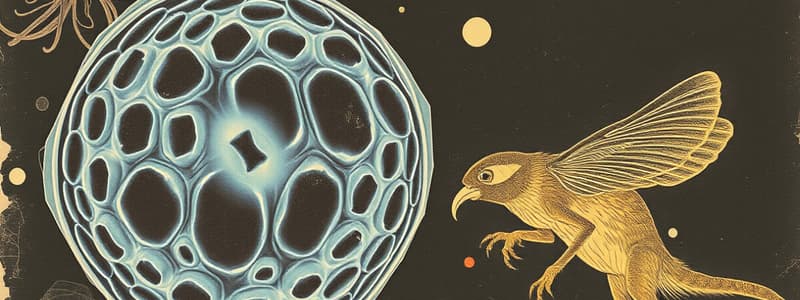Podcast
Questions and Answers
What is the primary function of bone cells?
What is the primary function of bone cells?
- To store minerals and provide support to the body (correct)
- To produce energy for muscular movement
- To facilitate the reproduction process
- To serve as a protective barrier against pathogens
Which type of cell is specialized for contraction and movement in the body?
Which type of cell is specialized for contraction and movement in the body?
- Stem cells
- Muscle cells (correct)
- Epithelial cells
- Bone cells
Which statement is true regarding embryonic and adult stem cells?
Which statement is true regarding embryonic and adult stem cells?
- Adult stem cells are found in larger quantities than embryonic stem cells in the body
- Embryonic stem cells are derived from adult tissues
- Adult stem cells are more versatile than embryonic stem cells
- Embryonic stem cells have a greater potential to differentiate into various cells (correct)
Which type of muscle cell is responsible for involuntary movements in the body's organs?
Which type of muscle cell is responsible for involuntary movements in the body's organs?
What type of cell is crucial for human reproduction?
What type of cell is crucial for human reproduction?
Stem cells that have a more limited ability to differentiate are known as:
Stem cells that have a more limited ability to differentiate are known as:
What is the primary function of xylem in plants?
What is the primary function of xylem in plants?
Which of the following is NOT a type of muscle cell?
Which of the following is NOT a type of muscle cell?
What is a primary role of stratified squamous epithelial cells?
What is a primary role of stratified squamous epithelial cells?
Which type of cell is responsible for sending electrical signals in the body?
Which type of cell is responsible for sending electrical signals in the body?
What type of cells are primarily involved in the immune response?
What type of cells are primarily involved in the immune response?
Which component of phloem is mainly responsible for transporting sugars?
Which component of phloem is mainly responsible for transporting sugars?
What is the primary function of fat cells in the body?
What is the primary function of fat cells in the body?
Which type of epithelial cell is specifically mentioned in the context of lining the mouth?
Which type of epithelial cell is specifically mentioned in the context of lining the mouth?
Which cell type is involved in forming clots to prevent bleeding?
Which cell type is involved in forming clots to prevent bleeding?
Which type of plant cells is involved in the transport of water and minerals from the roots to the leaves?
Which type of plant cells is involved in the transport of water and minerals from the roots to the leaves?
Which of the following statements best describes a distinguishing feature of prokaryotic cells?
Which of the following statements best describes a distinguishing feature of prokaryotic cells?
Which organelle is NOT typically found in eukaryotic cells?
Which organelle is NOT typically found in eukaryotic cells?
What does the prefix 'pro' in prokaryotic cells refer to?
What does the prefix 'pro' in prokaryotic cells refer to?
Which of the following is a characteristic of eukaryotic organisms?
Which of the following is a characteristic of eukaryotic organisms?
Which of the following is an example of a prokaryotic organism?
Which of the following is an example of a prokaryotic organism?
What is the main difference between prokaryotic and eukaryotic cells in terms of organelle structure?
What is the main difference between prokaryotic and eukaryotic cells in terms of organelle structure?
Which organelle is responsible for energy production in eukaryotic cells?
Which organelle is responsible for energy production in eukaryotic cells?
Which of the following statements about eukaryotic cells is false?
Which of the following statements about eukaryotic cells is false?
Flashcards are hidden until you start studying
Study Notes
Protection and Specialized Cells
- Stratified squamous epithelial cells in frogs provide protection against damage.
- Sperm and eggs are essential gametes for human reproduction.
Types of Animal Cells
- Bone Cells: Form bone tissue; functions include protecting organs, providing structural support for movement, and mineral storage (calcium, phosphorus).
- Muscle Cells: Responsible for contraction to move and stabilize body parts; three types include skeletal, smooth, and cardiac muscle.
- Stem Cells:
- Embryonic Stem Cells: Derived from embryos (blastocyst stage, 3-5 days old), they have the potential to become any cell type.
- Adult Stem Cells: Found in small numbers in adult tissues (like bone marrow), they have limited differentiation potential compared to embryonic stem cells.
Plant Vascular Tissue
- Xylem: Transports water and minerals from roots to leaves; composed of vessel elements, tracheids, and parenchyma cells.
- Phloem: Distributes organic nutrients (sugars) produced in photosynthesis; consists of sieve tube elements, companion cells, and fibers.
Kidney and Blood Cells
- Nephron Cells: Small units in kidneys that filter blood and remove waste.
- Nerve Cells: Transmit electrical signals throughout the body, linking the brain and organs.
- Red Blood Cells: Carry oxygen from the lungs to tissues.
- White Blood Cells: Help combat infections and diseases.
- Platelets: Small fragments that play a crucial role in blood clotting.
- Fat Cells: Store energy in the form of fat.
- Epithelial Cells: Protect underlying structures; an example includes squamous epithelial cells lining the mouth.
Prokaryotic vs. Eukaryotic Cells
- Eukaryotic Cells:
- Multicellular organisms with complex structures, including organelles like nuclei and mitochondria.
- Examples include bees, mushrooms, green algae, monkeys, flowers, and yeast.
- Prokaryotic Cells:
- Unicellular and simpler, lacking membrane-bound organelles; best exemplified by Escherichia coli bacteria.
- Common prokaryotic organisms include blue-green algae and mycoplasma.
- Prokaryotes, especially bacteria, reproduce rapidly.
Studying That Suits You
Use AI to generate personalized quizzes and flashcards to suit your learning preferences.



